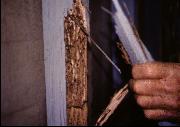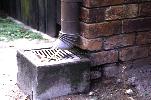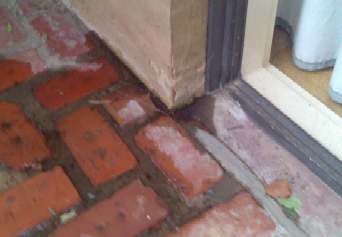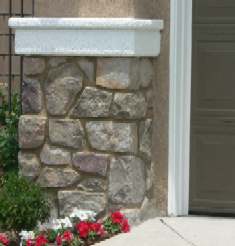Simple ways to avoid meeting termites
In the wild, pest termites usually get by quite happily eating sickly trees or the leftover bits of trees, and the safest, moist and tasty bits are usually underground or right in the middle of big pieces of timber. If your home/building/structure has big bits of wood that are dark or damp or close to the soil then your chances of avoiding termite problems are reduced.

Subterranean & dampwood termites
Subterranean termites usually get about by tunneling underground and entering their food from below. Tree roots are usually attached to trees and termites often travel from root to root great distances underground (there’s almost always a small air gap under a big root, so they don’t even have to dig as much). Timber waste buried around buildings usually leads to better food inside. Sometimes the termites just fly in and start up a fresh colony, but tunnelling is more common, because big bits of damp wood suitable for nesting are more often outside, not in. Dampwood termites don’t tunnel nearly as much but can fly in just as easily.
Since the termites are most likely to try to get in via the soil, there are some simple things you can do:
Control moisture:
- All types of termites need moisture. Keep your structure dry and well ventilated.

A free drink - Ventilate all possible subfloor areas and ensure the vents are kept free and clear. Make sure you wet areas inside (kitchen/bathroom/dungeon) are well vented. Wood can get wet, but must not stay wet.
- Fix all plumbing leaks. Particularly showers and baths. These often have leaks supplying constant moisture that makes the wood just right to be eaten.
- Check all gutters and down spouts, make sure that the water ends up well away from the house. Ideally down spouts should connect to stormwater drains. If you don’t have these, at least redirect the water well away from the house. Down spouts which regularly splash near the structure may be supplying an irresistible source of moisture.

Biochemist’s paving blunder - Avoid having gardens directly against walls–if you must do this, provide space for air movement between the vegetation and the wall and an inspection zone of at least 100 mm. Never have sprinklers wetting the soil near a building or deck. Termites have even been known to enter a building through branches touching walls.
- Make sure that any paving is angled to drain surface water away from the structure. You’d be amazed how often this is done wrong. Some people even build outdoor paving higher than the interior floor level . . . like in this photo of the paving around my house.
Be careful with timber in ground contact:
- Remove any timber or cellulose material stored on the ground beneath a suspended floor. That includes cardboard boxes and old newspapers, even cotton materials. Clean up any off cuts left during construction. The aim is to maximize the distance between termites and their potential meal.

Polystyrene - Don’t store any firewood in ground contact. This attracts termites. It also prevents the wood drying properly and hence reduces the heat yield on burning (it takes energy to boil water). Set your firewood at least 100 mm above ground (a shelf ot trench-mesh sitting on cinder blocks is a cheap solution).
- Structural wood in ground contact should be either termite resistant or treated with a preservative. Better yet, cut it off and mount it on a metal stirrup set in concrete. High and dry is always best.
- Don’t provide hidden entry points where temites can walk in unseen. Stucco can hide termite freeways and rigid foam slab-edge insulation can be a nightmare, providing termites with easy and secure tunnel space where you can’t see them. Instead, provide an impervious inspection zone. Use long-life physical barriers in all new construction.

Hidden entry paths There’s a trend in the USA now to have stone veneers in ground contact. All these concealing wall finishes create a major risk.
Drywood termites
Drywood termites can live in small pieces of wood so long as it is a little moist and not too hot or cold. They’ll fly in and start their colonies right in that wood. Best way to keep them at bay is to disguise your timber.
- Too Dry:Keeping timber very dry will make it impossible for termites to live, but this is impractical in many tropical and coastal areas where the natural humidity is sufficient to keep the wood moist enough for drywood termites. Do what you can to keep timber as dry as possible.
- Disguised:If they don’t know it is wood, they may not find it. Keep all exterior wood well coated with paint or varnish, especially the larger bits and at the joins and ends. Drywood termites begin their attack with just two termites. First the female selects a likely place to live and then pairs up with a male before they start tunnelling. So if you can make the wood unattractive, the termites won’t even try. A bit of preservative can go a long way. If it doesn’t taste good, the termites won’t hang around.
- Inaccessible:If they can’t get to the wood they can’t eat it. Seal up any cracks or fissures (these make it easy for them to get in). Cover vents with fine mesh screening (about 0.8 to 1.0 mm openings–but remember, you may need to increase the vent size to make up for this restriction of air flow). Pay particular attention to the roof and wall frames.
Following these simple points will greatly reduce your termite hazard. Best of all is to design your structure to be termite resistant from the very beginning. Remember too, that regular inspections can locate termites before they do any major damage.
